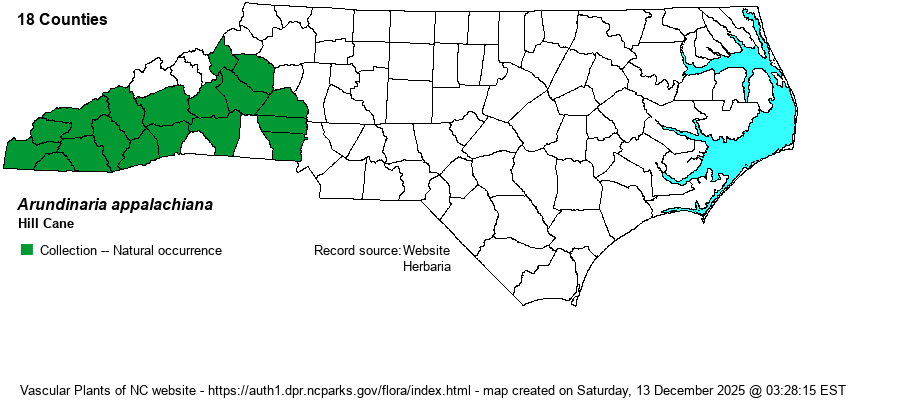| Author | Triplett, Weakley, & L.G. Clark | |
| Distribution | Throughout the southern 60-70% of the Mountains and the southwestern 25% of the Piedmont. Ranges east to Gaston and Catawba counties and north to Avery and Caldwell counties. Essentially not found farther eastward, although specimens from rocky slopes in the mid-lower Piedmont need ID check.
This recently described species is a Southern Appalachian endemic, ranging north only to western NC and south to northern GA and northeastern AL. It does occur in eastern TN.
| |
| Abundance | Fairly common to common in the lower mountains and foothills. Not numerous over perhaps 3500 feet elevation. Much is still to be learned about its abundance and habitats. | |
| Habitat | This woody grass is found essentially only on dry to mesic slopes of hardwood or mixed forests. It occurs in sizable stands (as do most members of the genus). It is not generally found in wetlands such as bottomlands and along creeks where other Arundinaria species are found. Its common name reflects this habitat. | |
| Phenology | Probably flowers and from April to July, but as with other canes, it flowers and fruits only infrequently, mainly after fire or just prior to death. Most folks never see these species fruiting. | |
| Identification | This is the knee-high and deciduous cane that grows in uplands in the southwestern part of the state, on forested slopes. It always occurs in extensive stands. It seldom reaches 3’ tall, and is mostly 1-2’ tall. Other canes occur mainly in bottomlands, swamps, along creeks, or in wet thickets and are normally 3’ tall and higher; also, they remain green all winter. As this species was only described in 2006, though it was unofficially known for decades as a “different” and upland cane, many biologists in the eastern half of the state are likely not familiar with it. However, it is normally not hard to find in the southwestern part of the state, once you are aware to look for stands of cane growing on upland slopes. See also the account for Pseudosasa japonica. | |
| Taxonomic Comments | This taxon had been recognized as a likely new entity as far back as 1900, according to Weakley (2018), but it was not until 2006 that it was formally described. Thus, the name “appalachiana” had apparently not previous been given to this form as a variety, etc. There appears to be complete agreement among recent references that this is indeed a valid species.
The 3 species of Arundinaria are the only native bamboos in NC. Like bamboos globally, they typically flower/fruit only sporadically and plants usually die following reproduction. Roadside, backyard, and waste lot colonies of very tall, yellow-stemmed bamboos are aliens from eastern Asia. | |
| Other Common Name(s) | None | |
| State Rank | S4 | |
| Global Rank | G4 | |
| State Status | | |
| US Status | | |
| USACE-agcp | | |
| USACE-emp | | |

